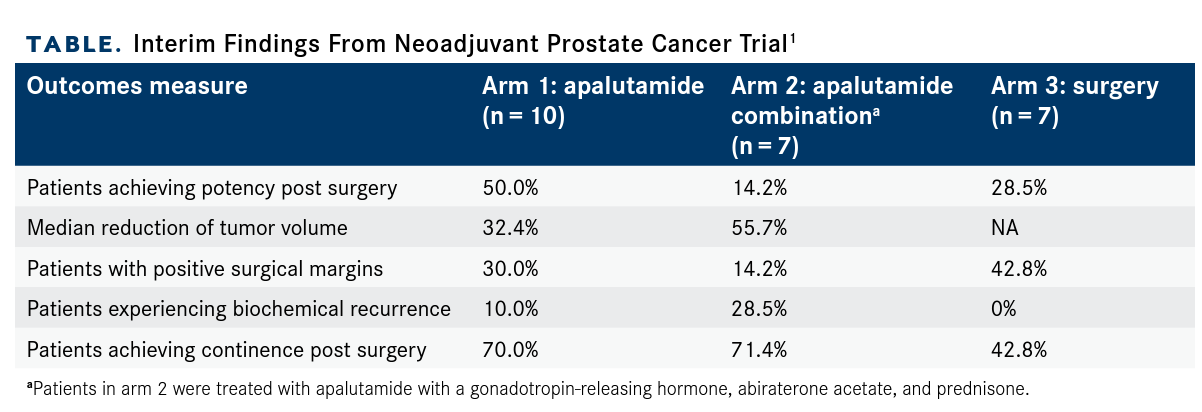Publication
Article
Oncology Live®
Neoadjuvant Apalutamide May Shrink Prostate Tumors
Author(s):
Interim data from a phase 2 study indicate that neoadjuvant hormone therapy may reduce tumor volume in men with high-risk prostate cancer planning to undergo radical prostatectomy.
Joshua Sterling, MD

Interim data from a phase 2 study presented at the 2020 American Urological Association Annual Meeting indicate that neoadjuvant hormone therapy (NHT) may reduce tumor volume in men with high-risk prostate cancer planning to undergo radical prostatectomy (RP). Positive trends supported increased sexual potency preservation without an adverse effect on positive surgical margin rates, according to lead author Joshua Sterling, MD, who detailed the findings during a podium session.1
“Historically, [NHT] has been shown to improve pathologic outcomes. Therefore, neoadjuvant androgen deprivation therapy may allow a nerve-sparing surgical approach to increase postsurgical quality-of-life outcomes without compromising oncologic outcomes,” said Sterling, a chief resident in the Department of Surgery, Division of Urology, at Rutgers Robert Wood Johnson Medical School in New Brunswick, New Jersey.2
Although neoadjuvant systemic therapy is a widely accepted treatment paradigm in many malignancies, the use of androgen deprivation is not widely endorsed in the localized disease setting of prostate cancer. The use of NHT was initially studied in the 1990s, when results by Labrie et al demonstrated an improvement in pathologic outcomes, but follow-up data failed to show improvement in overall survival.1,2
For men with high-risk localized prostate cancer who choose to have surgery, wide resection of the neuromuscular bundle leads to best oncologic control, but this aggressive tumor control approach comes with adverse effects such as impotence and postoperative continence, Sterling noted.
Investigators sought to evaluate the impact of NHT in advance of RP in a prospective 3-arm study (NCT02949284) that so far has enrolled 42 patients to date. Patients are randomized to receive either apalutamide (Erleada; arm 1); apalutamide plus a gonadotropin-releasing hormone, abiraterone acetate (Zytiga), and prednisone (arm 2); or surgery alone (arm 3). Patients in arms 1 and 2 will undergo RP 3 months after treatment completion. Follow-up for all 3 arms will proceed for 2 years. The target accrual is 90 patients and includes individuals with a Gleason score greater than 8 on a biopsy or a prostate-specific antigen (PSA) score that exceeds 20 ng/mL.
The primary end point is the postsurgical potency rate at 12 months, which is defined as being able to penetrate and complete sexual intercourse satisfactorily in more than 50% of attempts. Secondary end points include change in tumor volume, biochemical recurrence rate, positive surgical margins rate, postoperative continence rate, and quality-of-life assessment.1
Thirty-two patients were included in this current analysis (Table).1 Four patients withdrew from the study following randomization, 1 patient was declared ineligible, 3 patients continue to receive neoadjuvant treatment, and 24 patients are in the follow-up phase. Arm 1 consisted of 10 patients and arms 2 and 3 had 7 patients each.
Table. Interim Findings From Neoadjuvant Prostate Cancer Trial1

A median reduction of tumor volume was observed in 32.4% of patients in arm 1 and 55.7% in arm 2. There was no pathological complete response, Sterling said. Surgical margins were positive in 3 patients in arm 1, 1 patient in arm 2, and 3 patients in arm 3. Potency was achieved in 50% of patients in arm 1, 14.2% of patients in arm 2, and 28.5% of patients in arm 3.
All groups were well balanced, with median highest measured PSA levels of 11.8 ng/mL (range, 8.8-16.7), 19.9 ng/mL (range, 15.6-25.0), and 8.9 ng/mL (range, 7.7-17.8) in arms 1, 2, and 3, respectively. Median PSA level reduction after neoadjuvant therapy was 11.2 ng/mL (range, 8.5-15.2), 19.8 ng/mL (range, 15.4-24.8), and not available in arms 1, 2, and 3, respectively. Serum testosterone level recovered to baseline post operatively.
“The median follow-up time for arms 1 and 2 has not reached maturity to appropriately assess continence or potency rates,” Sterling said. “However, at the time of analysis, 5 patients in arm 1 [P = .25] and 1 patient in arm 2 [P = .21] have achieved potency compared with 2 patients in arm 3,” he said.
Seven patients in arm 1 (P = .14) and 5 patients in arm 2 (P = .22) have achieved continence compared with 3 patients in arm 3. Three patients have experienced a biochemical recurrence to date. This was reported in 1 patient in arm 1 and 2 patients in arm 2.
“These interim results are promising,” Sterling concluded. “However, complete accrual will be necessary to confirm these early observations.”
References
- Sterling J, Chua K, Patel HV, Kim I. Interim analysis of phase 2 randomized prospective study on neoadjuvant apalutamide/abiraterone acetate with prednisone and the feasibility of performing nerve-sparing radical prostatectomy in men with high-risk prostate cancer (NCT02949284). J Urol. 2020;203(suppl 4):e249. Abstract PD10-09. doi:10.1097/JU.0000000000000844.09
- Labrie F, Cusan L, Gomez JL, et al. Downstaging by combination therapy with flutamide and an LHRH agonist before radical prostatectomy. Cancer Surv. 1995;23:149-156.










